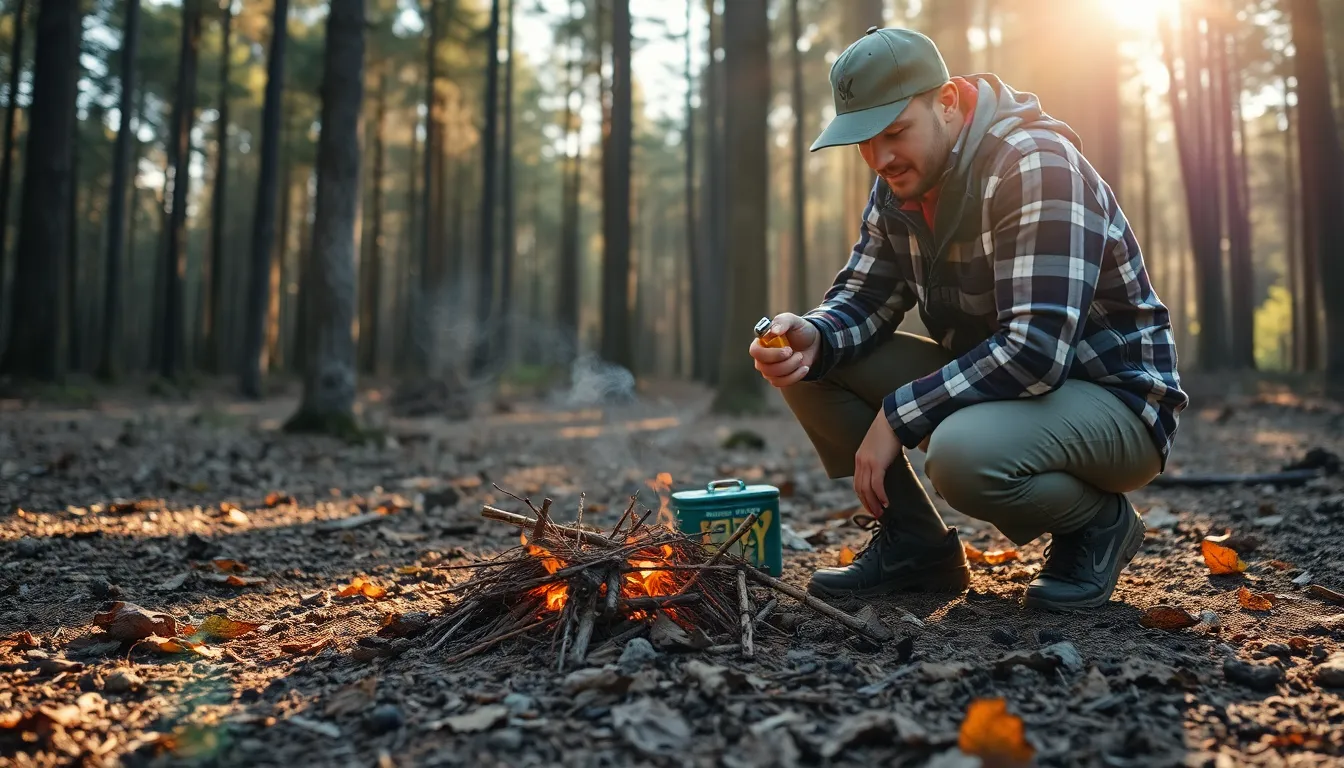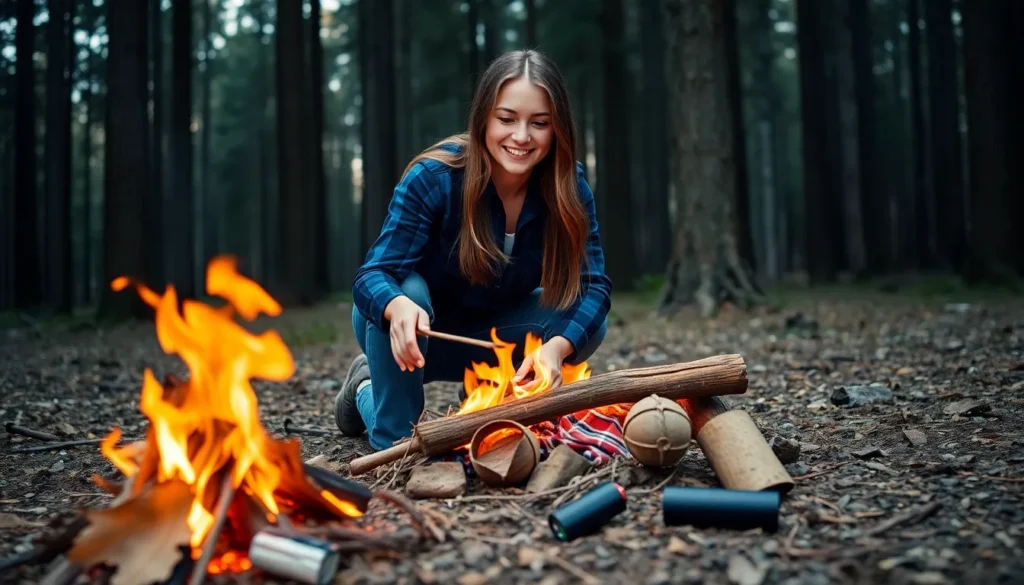In a world where everything seems to be just a swipe away, the ancient art of fire lighting remains a timeless skill that sparks curiosity and excitement. Whether it’s for a cozy campfire, a backyard barbecue, or a survival situation, knowing how to light a fire can turn a chilly evening into a warm gathering or even save the day. Plus, who doesn’t want to impress friends with their fiery prowess?
Table of Contents
ToggleUnderstanding Fire Lighting Techniques
Fire lighting techniques remain crucial in various scenarios, from survival situations to creating inviting atmospheres. Understanding these methods enhances practical skills and showcases a historical connection to humanity’s evolution.
Historical Context of Fire Lighting
Throughout history, fire lighting methods evolved significantly. Early humans utilized friction-based techniques, like the bow drill, to create flames. They relied on natural materials, such as dry grass and spark-producing stones, to ignite fires. Cultures across the globe adopted unique methods that reflected their environments. For instance, Indigenous Australians mastered the ember stick technique for quick ignition. These historical methods laid the groundwork for contemporary practices, underlining the importance of fire in human civilization.
Modern Fire Lighting Methods
Modern fire lighting methods incorporate both traditional skills and advanced tools. Matches and lighters offer convenience for quick ignitions in everyday circumstances. Portable fire starters, such as magnesium blocks, present reliable alternatives for outdoor activities. Fire pits often utilize propane or natural gas, simplifying the process while maintaining safety. Outdoor enthusiasts frequently combine techniques, experimenting with tinder and kindling to ensure a successful flame. Emphasizing safety remains paramount as various methods adapt to specific situations and user needs.
Essential Tools for Fire Lighting

Effective fire lighting requires the right tools to ensure success in various situations. Both natural materials and modern equipment play crucial roles in this skill.
Natural Materials for Fire Starters
Natural materials serve as excellent fire starters. Dried leaves, twigs, and grasses ignite quickly, creating a strong initial flame. Pine needles and resin-rich woods provide excellent options due to their high flammability. Bark from cedar or birch can also assist in igniting tinder easily. Collecting these items before starting a fire enhances efficiency and effectiveness. It’s best to arrange them in a teepee structure, allowing airflow to support flame development.
Modern Fire Lighting Equipment
Modern fire lighting equipment includes tools that blend convenience with effectiveness. Matches provide a classic yet reliable option, easily stored in waterproof containers. Lighters offer quick ignition with just a flick, making them user-friendly. Solar-powered ignition devices utilize sunlight to create fire, showcasing modern ingenuity. Portable fire starters, like magnesium rods or flint, facilitate fire creation with minimal effort. Choosing the right equipment depends on the context, whether for camping trips or emergency preparedness.
Safety Precautions While Fire Lighting
Safety remains a critical aspect of fire lighting. Always conduct fire lighting in well-ventilated areas to prevent smoke inhalation. Use flames within designated fire pits or fire rings when outdoors, reducing fire hazards. Additionally, keep a bucket of water or a fire extinguisher close by for emergencies.
Check local regulations related to outdoor fires. Adhering to these rules minimizes risks and maintains environmental integrity. Avoid lighting fires during high winds, as gusts can spread flames uncontrollably.
When using accelerants, exercise caution. Flammable liquids can lead to explosive fires if not used correctly. Opt for natural fire starters instead, such as dry leaves or twigs, ensuring a safer ignition process.
Supervise fires closely, especially around children and pets. Unattended flames pose dangers and can lead to accidents rapidly. When extinguishing flames, soak ashes thoroughly with water, ensuring no embers remain.
Know the signs of fire danger. Dry conditions increase the risk of wildfires, making fire lighting inadvisable. Educate companions on safety measures, promoting awareness and caution among all participants.
Consider wind direction when igniting a fire. Position the fire so that smoke drifts away from individuals and structures. Respect natural surroundings by keeping fires small and contained; this protects vegetation and wildlife.
Fire lighting can be enjoyable and safe when precautions are prioritized. Following these guidelines helps prevent accidents and ensures responsible fire use in various contexts.
Practical Applications of Fire Lighting
Fire lighting holds various practical applications in everyday life. Its significance extends beyond mere survival; it enhances experiences during outdoor adventures and emergency contexts.
Camping and Outdoor Activities
Camping trips benefit immensely from effective fire lighting techniques. Campfires create warmth and provide a gathering point for social interaction. Cooking meals outdoors becomes easier with a reliable fire. Making s’mores or warming up canned soups showcases the joy of a campfire. Properly constructed fires can repel insects and serve as a beacon in the wilderness. For those camping in uncertain conditions, mastering fire lighting ensures safety and comfort.
Emergency Situations
Fire lighting proves crucial in emergency situations. It offers warmth during unexpected cold weather or when stranded outdoors. In survival scenarios, fire enables cooking and purifying water, vital for sustenance. A visible fire source attracts rescuers in dire circumstances, enhancing chances of assistance. Creating a fire can signal for help or provide light at night. Skills in fire lighting can significantly impact survival rates, elevating its importance in urgent situations.
Mastering the art of fire lighting is a valuable skill that transcends time and technology. It not only enriches outdoor experiences but also serves as a vital tool in survival scenarios. By blending traditional techniques with modern conveniences, individuals can adapt their fire lighting methods to suit various situations.
Prioritizing safety ensures that this ancient skill is practiced responsibly, allowing for enjoyable and secure gatherings. Whether it’s for warmth during a chilly night or as a signal in emergencies, fire lighting remains an essential part of human experience. Embracing this skill can enhance one’s connection to nature and foster a sense of community.

